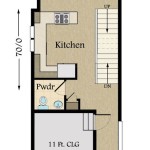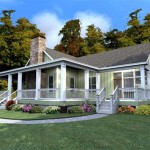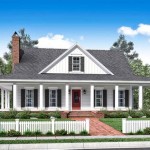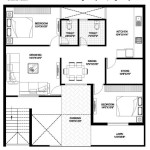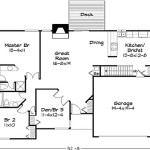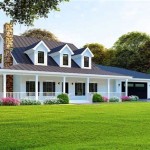One-Story Cottage House Plans: A Comprehensive Guide
One-story cottage house plans represent a significant segment of residential architecture, offering a unique blend of charm, functionality, and accessibility. These designs are characterized by their compact size, efficient use of space, and a distinct aesthetic appeal often associated with a simpler, more comfortable lifestyle. The appeal of one-story cottage homes spans various demographics, from young families and retirees to individuals seeking a low-maintenance and aesthetically pleasing living environment.
The term "cottage" itself evokes images of cozy and intimate dwellings, often rooted in historical architectural styles. While modern cottage designs may incorporate contemporary elements, the core principles of simplicity, functionality, and connection to the surrounding environment remain central to their appeal. This article will delve into the various aspects of one-story cottage house plans, exploring their benefits, key design considerations, and diverse stylistic interpretations.
Benefits of One-Story Cottage House Plans
One-story cottage house plans offer several advantages that make them an attractive option for a wide range of homeowners. These benefits extend beyond aesthetics, encompassing practical considerations related to accessibility, maintenance, and overall livability.
Accessibility is a primary advantage of single-story living. Eliminating stairs makes these homes ideal for individuals with mobility challenges, including the elderly and those with disabilities. This design also facilitates easier movement for young children and simplifies tasks such as carrying groceries or laundry throughout the house. The inherent accessibility contributes to a safer and more convenient living environment for all occupants.
Maintenance is generally easier and less expensive in a one-story cottage. Tasks such as cleaning gutters, repairing roofs, and painting exterior walls are significantly simplified without the need for ladders or scaffolding. This reduced maintenance burden translates to lower long-term costs and allows homeowners to spend less time on upkeep and more time enjoying their home.
Heating and cooling efficiency can also be enhanced in a one-story design. With all living spaces on a single level, temperature regulation is often more consistent and efficient, reducing energy consumption and lowering utility bills. This is particularly true in regions with extreme climates, where multi-story homes may experience significant temperature variations between floors. The compact design of a cottage further contributes to its energy efficiency, minimizing the surface area exposed to the external environment.
Finally, one-story cottages often foster a stronger connection to the surrounding landscape. With direct access to the outdoors from multiple points in the house, residents can easily enjoy gardens, patios, and other outdoor living spaces. This seamless integration of indoor and outdoor living enhances the sense of tranquility and connection to nature that is often associated with cottage-style homes.
Key Design Considerations for One-Story Cottages
Designing a one-story cottage requires careful consideration of several factors to maximize space, functionality, and aesthetic appeal. Efficient space planning is paramount, as all living areas must be accommodated within a single level. Thoughtful attention to detail is essential to create a comfortable and inviting living environment.
Open floor plans are frequently employed in one-story cottage designs to create a sense of spaciousness and improve flow between living areas. Combining the kitchen, dining room, and living room into a single, unified space allows for greater flexibility and encourages social interaction. Strategic placement of windows and doors is crucial to maximize natural light and ventilation throughout the home.
Roof design plays a significant role in the overall aesthetic of a cottage. Gable roofs and hip roofs are commonly used, often with dormers to add visual interest and provide additional headroom in attic spaces. The roof pitch and overhang can also influence the perceived scale of the house and its connection to the surrounding landscape. The material used for the roofing, such as asphalt shingles, cedar shakes, or metal, will directly affect the longevity and overall style of the cottage.
Exterior materials and detailing contribute significantly to the cottage's charm and character. Natural materials such as wood siding, stone accents, and brick are often incorporated to create a warm and inviting appearance. Decorative elements such as window boxes, shutters, and porches add visual interest and enhance the cottage's curb appeal. Carefully chosen paint colors and landscaping further contribute to the overall aesthetic harmony.
Interior design elements are equally important in creating a cohesive and comfortable living environment. Natural light should be maximized through the strategic placement of windows and skylights. Neutral color palettes, coupled with pops of color in furnishings and accessories, can create a bright and inviting atmosphere. The selection of furniture and décor should reflect the cottage's overall style and contribute to its sense of coziness and charm. Thoughtful attention to details such as trim, moldings, and hardware can further enhance the overall aesthetic and create a sense of timeless elegance.
Stylistic Variations in One-Story Cottage House Plans
One-story cottage house plans exhibit a wide range of stylistic variations, reflecting different regional influences, historical periods, and personal preferences. Understanding these variations can help homeowners select a design that best suits their aesthetic sensibilities and lifestyle needs.
English cottage designs are characterized by their steeply pitched roofs, dormer windows, and asymmetrical facades. These homes often feature stone or brick exteriors, adorned with climbing vines and lush gardens. The interior spaces are typically cozy and intimate, with exposed beams, fireplaces, and traditional furnishings. The overall aesthetic is one of timeless charm and rustic elegance.
American cottage designs often draw inspiration from the Arts and Crafts movement, emphasizing handcrafted details and natural materials. These homes typically feature wide porches, low-pitched roofs, and exposed rafter tails. The interior spaces are often simple and functional, with natural wood finishes, handcrafted tiles, and built-in cabinetry. The overall aesthetic is one of understated elegance and functional beauty.
Scandinavian cottage designs are characterized by their clean lines, minimalist aesthetic, and emphasis on natural light. These homes typically feature simple rectangular forms, large windows, and light-colored exteriors. The interior spaces are often bright and airy, with white walls, natural wood floors, and minimalist furnishings. The overall aesthetic is one of simplicity, functionality, and connection to nature.
Coastal cottage designs are adapted to suit the unique environmental conditions and aesthetic preferences of coastal regions. These homes often feature elevated foundations, durable exterior materials, and large windows to capture ocean views. The interior spaces are often casual and relaxed, with light colors, nautical-themed décor, and comfortable furnishings. The overall aesthetic is one of breezy elegance and coastal charm.
Modern cottage designs blend traditional cottage elements with contemporary architectural principles. These homes often feature open floor plans, clean lines, and sustainable materials. The exterior facades may incorporate a mix of traditional and modern materials, such as wood siding, metal accents, and large expanses of glass. The interior spaces are often bright and airy, with minimalist furnishings and contemporary finishes. The overall aesthetic is one of understated elegance and modern sophistication.
Beyond these broad categories, countless variations exist, allowing homeowners to tailor their cottage design to their specific needs and preferences. Whether one seeks a traditional English cottage, a modern Scandinavian retreat, or a unique blend of styles, the possibilities are endless. The key is to carefully consider the various design elements and stylistic influences to create a one-story cottage that is both aesthetically pleasing and functionally suited to its purpose.
The selection of a one-story cottage house plan is a significant decision, one that should be based on careful consideration of individual needs, lifestyle preferences, and budget constraints. Consulting with an architect or experienced home designer can be invaluable in navigating the design process and ensuring that the final product meets all expectations. Ultimately, the goal is to create a home that is not only aesthetically pleasing but also a comfortable, functional, and enjoyable living space for years to come.

One Story Cottage Style House Plan New Plans Small

Outlook Free Personal Email And Calendar From Microsoft Cozy House Exterior Sims Plans One Story

1 Bedroom Single Story Cottage With Open Living Space Floor Plan Plans Pool House Tiny

One Story Cottage House Plan

Mill Creek Cottage A One Story House Plan

Edgartown A One Story Cottage House Plan With 4 Bedrooms 9660

One Story House Plans With Open Floor By Max Fulbright

Small 1 Story Cabin Plans And Cottage Drummond House

Small House Plan 1 Story Cottage Style Home Floor

Backyard One Bedroom Cottage House Plan 560000tcd Architectural Designs Plans
See Also


